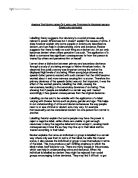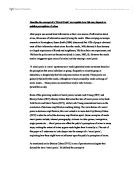Labelling theory is one used by criminologists which simply means; by describing someone as something they will eventually become it i.e. by calling someone greedy constantly, the theory is they will become greedy. It principally ‘views deviance as the creation of social groups and not the quality of some act or behaviour’ (Howard Becker’s Labelling theory, http://www.criminology.fsu.edu/crimtheory/becker.htm, accessed: 5/12/2010)
The media will always have an influence on the majority of the population’s lives, whether its BBC news or Sky Sports.
In 1989, a national disaster struck and the shameless media spared no expense in painting another inaccurate depiction, this time surrounding the Hillsborough catastrophe. The sequence of events which occurred from 2.30pm onwards that afternoon could have never been foreseen. As it was a FA cup match, the tickets were sold out, so everyone was expecting a crowded match, but as some LFC fans were late there was an unexpected bottle neck outside the gates. The fans were then directed by the police to the side door but were given no further direction. This resulted in many of them going down the same tunnel. They didn’t realise that in the pen on the other side people were already getting crushed due to over capacity. There was no other way out as the police refused to open the pen gate on the other side. As fans kept pouring in the tunnel, unaware of the tragic occurrences on the other side, the police failed to effectively communicate with each other or the public and I would go so far as to say they were completely negligent by firstly being unaware of what was going on in the stadium they were supposed to be monitoring and secondly by not heeding to the warnings that the turnstiles in place ‘did not give anything like the access to the ground needed by fans’ (scraton,page 60) Had the agreed major incident plan been executed it may have been possible to spare many of the 96 lives lost. ‘Eventually the two perimeter gates were opened revealing the full horror on the terrace below… Bodies were dragged from pens and laid down on the pitch’ and then carried to the gymnasium on makeshift stretchers which were actually advertising hoarding tore down by fans to help (scraton, page 60). An incorrect police statement was released almost immediately by the police in which it was stated that it could have been a possible pitch invasion which was a definite lie as pitch invasion suggests they were without ticket trying to ruin the game, when in fact many were season ticket holders who loved football and couldn’t wait to watch the match. The next lie was told again by the police in which they stated that the fans had forced open an exit gate and they themselves caused the inrush into the already crammed pens.(scraton, page 60).Instant condemnation of LFC fans followed these statements from the police.and within the ‘hour, the lens of hooliganism was firmly in place.’ (scraton page 62) This then had a domino effect on the media resulting in widespread portrayal of loyal LFC fans as criminals and deviants as ’quality is often sacrificed to quick fire sensationalism, hype and voyeurism’(scraton page 71) . And quality was indeed sacrificed along with good taste in many articles. The prime example of this was publishing photos of the dead in the immediate aftermath of the accident. The media’s intention here was clear: to satisfy the public appetite for extreme and shocking coverage, bearing no thought nor consideration for the families of the deceased. Journalism is supposed to be an informative way of communicating with the public on key issues, yet why is it time and time again the media abuse their position and make every attempt to cash in on others’ sorrow. The media did not stop at taring the reputation of those present at Hillsborough that fateful day, they transcended the events to be representative of the whole Liverpudlian community even comparing them to that of Neanderthal man (cohen as cited in scraton page 75). The wide range in media representation resulting in a ‘longer term drip, drip effect always associated with the consolidation of negative reputation whether derived from fact or fiction.’ (scraton page 75). As a result of this the Liverpudlian community have been ascribed a label of ‘rowdyness’ and ‘hooliganism’ which has meant that people outside of Liverpool have developed a fear of its unpredictability and due to this the possibility of crime. Because of this escalation in the media the citizens themselves may have a raised fear of crime due to the numerous claims on the illegitimacy of the community as presented by the media, ‘ Half of them can’t read and the other half are pinching hubcaps.’ This fear was unfounded and was purely a result of media manipulation of the facts.
Another sorrowful event was the Dunblane Shooting on 13th March 1996. It involved Thomas Hamilton, a local man who ran various boys’ clubs in the area. More recently his boys’ clubs methods were questioned as he told the boys to do the activities shirtless. The raising of the questions brought with them much ‘rumour, innuendo and accusation’. These types of accusation accumulated right up until the shooting. He acquired guns as he had a gun license and was a member of a gun club. Hamilton accused Dunblane primary school as being one of the authorities who were tainting his reputation. On the morning of 13th March, Thomas Hamilton entered Dublane primary school and shot out at children and teachers – murdering sixteen children and one teacher. It seems that the attack was pre-meditated as some of the boys in his boys club had reported that Hamilton had been questioning them on the layout of the school.
The media portrayed Hamilton as an outcast of society, labelling him a ‘madman’, a ‘devil’ and a ‘misfit’, in effect the media monstered him. He was said to be a man everybody avoided, who induced feelings of fear in relation to contact with children due to rumours of paedophilia which surrounded him. Yet, in actual fact many of the community must have trusted him as he retained the leadership of his boys clubs until the massacre. It appears here that the media have construed a false impression of the neighbourhood consensus towards Hamilton before the attack; blinded by the exposition of his character which the attack itself revealed. This is a prominent feature, as discussed in previous examples, of how knee-jerk labels do not usually ring true to the overarching truth.
This incident caused moral panic as many feared there could be a Hamilton in their areas across the nation and so pressure was put upon MP’s to increase gun control, and the pressure was successful in achieving such control measures. Therefore it is logical to see that the incident greatly increased fear of crime.
To conclude, I feel the extent to which the media has an impact on the fear of crime depends importantly on the context of each situation. It would be unfair for me to say that all media has a grand impact on the fear of crime, based solely on the three examples I have used. However, what these examples illustrate is the motivation of the media to produce material which will attract public attention. The crucial factor of whether or not the coverage will impact on the fear of crime is how widespread the labels produced by media institutions reach. These examples have caused me to scrutinize much more of the media I come across and scrutiny I feel is the key aspect to be considered in avoiding an unfounded fear of crime.







